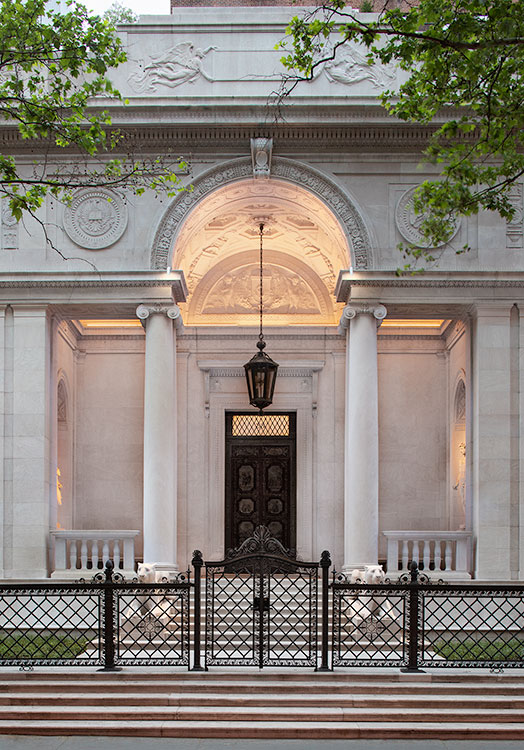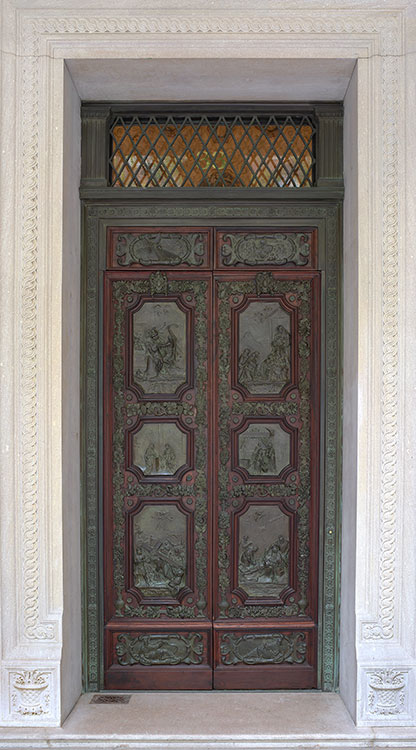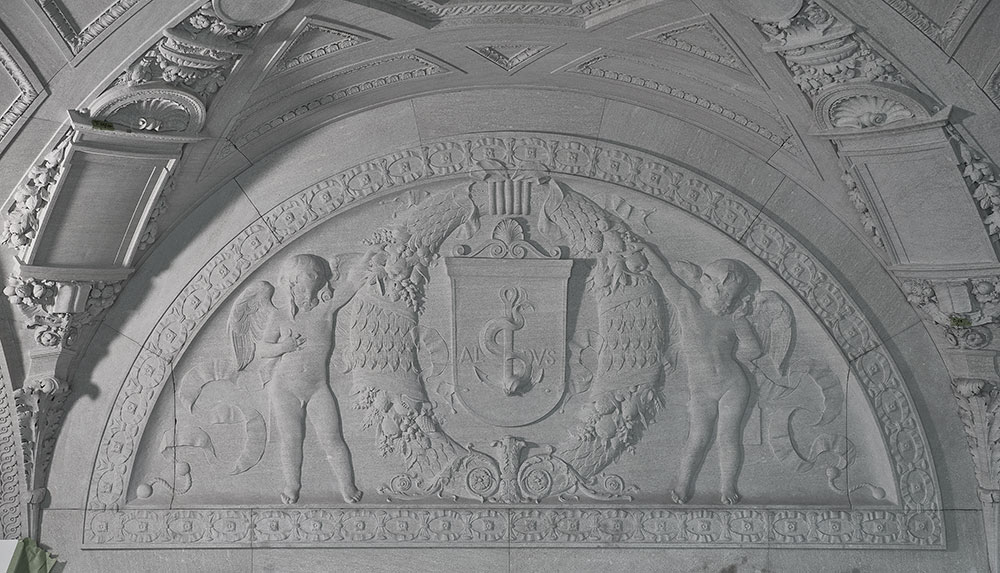Stop 50. 36th Street Promenade Exterior

Colin B. Bailey, Director
If you exit the Morgan and walk along 36th Street, you will be able to enjoy the architecture of Benjamin Wistar Morris’s Annex, Renzo Piano’s Thaw Gallery, and McKim, Mead & White’s original Library as you head east. A delightful surprise is the newly conceived landscaping that surrounds these buildings, designed by landscape architect Todd Longstaffe-Gowan and unveiled in summer 2022.
Stop 51. The Façade

Colin B. Bailey, Director
From 1902 to 1906, hundreds of people worked to fulfill Morgan’s commission and realize McKim’s design, from the quarrymen who extracted the stone in east Tennessee to the masons who set the blocks with exquisite precision. More than a century later, a contemporary team of specialists has honored their labor by restoring this well-made building, cleaning and repairing the façade, statuary, and front doors, as well as the elegant bronze perimeter fence. The restoration respects and enhances the restrained façades of both the original Library and Renzo Piano’s addition.
Stop 52. Edward Clark Potter’s Lionesses

Aside from a collection of books, what does the J. Pierpont Morgan Library have in common with the New York Public Library (NYPL) on 42nd Street? Our lions!
The lionesses that flank the original entrance to our Library building were created by the acclaimed sculptor, Edward Clark Potter, who also created the lions at the entrance of the NYPL. The lions at the NYPL were completed in 1911, several years after our library and lionesses were completed and remain an important marker of our library building today.
During the restoration of our library building, our lionesses have also received some special treatment. After spending several months in hibernation protected by protective boxes, our duo received a thorough cleaning, followed by a surface treatment to ensure they are protected for years to come. Both of our lionesses had their ears renewed through a hand-carved dutchman repair to fill loss that occurred over the years. The restoration has given a new life to our lionesses, who are ready to continue guarding our building for years to come.
Deirdre Jackson, Assistant Curator of Medieval and Renaissance Manuscripts
McKim’s friend Daniel Chester French, one of the most prominent American sculptors of the day, recommended that the architect engage Edward Clark Potter to sculpt the marble lionesses that grace the Library’s entrance. In 1903, Potter was awarded a commission of $10,000 to sculpt the female guardian lions that would be placed on inclined pedestals on either side of the front steps. He sketched live models at the new Lion House at the Bronx Zoo and then sculpted a lioness in clay in his studio in Greenwich, Connecticut. Next, plaster models were made to guide the stonecutter, who worked with large blocks of Tennessee marble. Potter likely hired John Grignola, an accomplished Italian immigrant carver, to execute the work.
Potter went on to sculpt the celebrated male lions that were installed outside the New York Public Library in 1911.
Stop 53. Entrance Doors

Jennifer Tonkovich, Eugene and Clare Thaw Curator of Drawings and Prints
Though the doors to the Morgan Library evoke Italian Renaissance precedents such as Lorenzo Ghiberti’s doors for the Florence Baptistery, they were a modern creation. Likely the work of American sculptor Waldo Story, the doors were sold through the Florentine dealer Stefano Bardini and his agents and passed through a series of dealers before reaching New York. They were installed at the Library in October 1904. Their purported Renaissance origins, masking their contemporary creation, led to confusion that has only recently been clarified through archival research.
The heavy wood doors are made of walnut with mahogany moldings. Each measures nine-and-a-half feet tall and is adorned with cast bronze panels that depict scenes in the life of Christ. A modern touch is the doorbell, which is cleverly concealed in one of the perimeter rosettes at right.
See video: Restoration of J. Pierpont Morgan's Library: Doors
Stop 54. Loggia Sculpture and Reliefs

John McQuillen, Associate Curator of Printed Books and Bindings
McKim’s design for the exterior of the Morgan was austere, with a few additions of sculpture and decorative flourishes mostly reserved for the porch. The effect is even more spartan than initially proposed, since the niches in the façade were never filled with sculpture and the ones on the porch are occupied solely by marble figures purchased in 1909.
Visitors to J. Pierpont Morgan’s Library entered through a bronze gate along 36th Street and ascended a short flight of steps to the loggia. As they approached the massive doors, they stepped across slabs of rose and green marble, the only touches of color against the pink-white blocks of the building’s exterior. Looking up, they would have seen a vaulted ceiling adorned with marble carvings of notable printers’ marks.
The relief in the half-circle above the doors depicts the mark of the Aldine Press, the celebrated publishing house of the Venetian scholar and printer Aldus Manutius. It was designed by McKim, Mead & White, modeled by Andrew O’Connor, and carved by the Piccirilli brothers, New York’s most distinguished Italian immigrant stone carvers.
O’Connor, an Irish American artist, was commissioned to execute much of the Library’s exterior relief sculpture, but his contract was scaled back when he failed to progress quickly enough to satisfy McKim and Morgan. After O’Connor was relieved of his commission for the rectangular exterior reliefs, Adolph Weinman stepped in to design them.